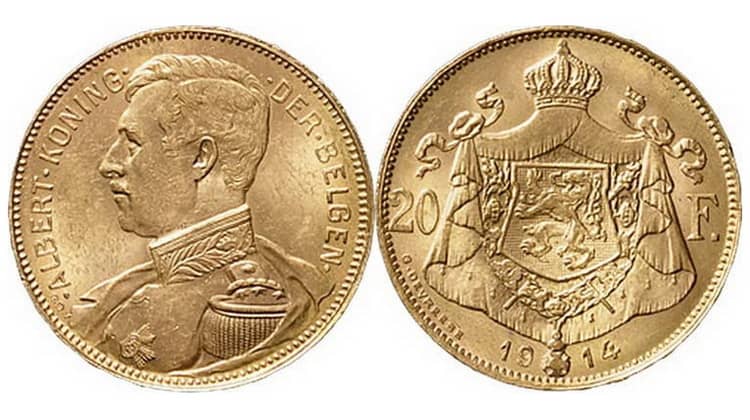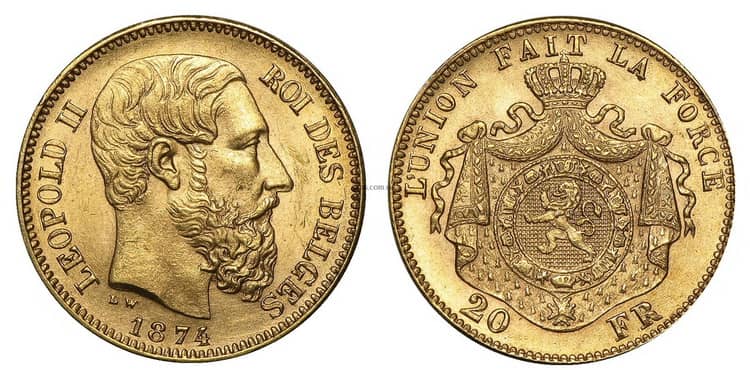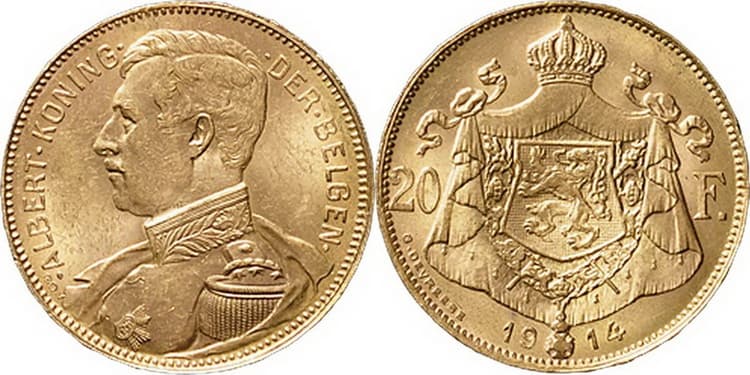
20 Belgian francs (1867-1914) – a series of coins of regular coinage, issued by the mint of Belgium between the reign of Leopold II and Albert I. At the beginning of the 20th century, the Kronenthaler was used in Belgium, then the guilder, since the country was a part of the Austrian Netherlands. However, the conquest of the greater part of Western Europe by the revolutionary and Napoleonic France led to the widespread expansion of the French franc. It was temporarily adopted as legal tender even in Austria. After gaining independence in 1830, the ruler of new Belgian kingdom did not abandon the usual currency, and his own franc, equivalent to French one, began to be minted at the mint of Brussels. The coins with a face value of 20 francs of this period of coinage were made from gold exclusively. All 20 Francs Belgian gold coins in our catalog.
Coins of Leopold II reign
Years of minting: 1867-1882
Metal: gold
Diameter: 21 mm
Weight: 6.452 g
Edge: inscription «DIEU PROTÈGE LA BELGIQUE»
Minting type: regular issue
Designer: Leopold Wiener
The obverse of the coin depicts the portrait of King Leopold II, year of coinage and the initials of the designer. On the obverse there are inscriptions “Leopold II” and “King of Belgium”. The coat of arms of the state and denomination is on the reverse side of the coin are. All 1865-1909 Leopold 2 Belgian gold coins in our catalog.

Coins of Albert I reign
Years of minting: 1914
Metal: gold
Diameter: 21 mm
Weight: 6.451g
Edge: inscription «DIEU PROTÈGE LA BELGIQUE»
Minting type: regular issue
Designer: Godefroid Devreese.
The coins were issued in two versions, French and Dutch. On the obverse of both coins there is a portrait of King Albert I. There are inscriptions Albert I and ALBERT ROI DES BELGES (the French coin version), ALBERT KONING DER BELGEN (the Dutch version of the coin) on the obverse. On the reverse side of the coins there are the coat of arms of the state, denomination and year of minting.

Cost of coins
As a rule, all antique Belgian coins, especially gold and silver, are highly valued by investors and collectors. The price of coins of the coinage period from 1867 to 1882 may be 270-290 US dollars per copy. The coins of the same period of the reign of King Albert I are slightly more expensive – from $ 290 to $ 400. All Belgian gold coins in our catalog.
History of Belgian coins
In 1865, Belgium, France, Switzerland, and Italy created the Latin Monetary Union, to which Greece joined in 1868. Under the terms of the treaty, each country of the union minted a national currency unit (lira, franc, drachma) worth 4.5 grams of pure silver or 290.32 mg of fine gold. All coins supposed to be freely exchanged at a rate of 1:1. In the 1870s the value of gold became a fixed standard, a similar situation lasted until 1914.
Albert I became the successor to his uncle Leopold II in 1909, and he has to take measures to keep a stable course of the national coin. The Latin monetary union ceased to fully perform its function, as there was a lack of a stable course of gold and silver in the world markets, not to mention other valuable metals, as well as a wider use of paper notes. At the very beginning of his reign, Albert imposed a prohibition of the coinage of gold coins. Despite this, Belgium remained faithful to the Latin Monetary Union and left it only in 1925, two years before its final abolition.
A few days before the outbreak of World War I, Albert I released an order for the minting of a 20-franc gold coin. It had was issued in a circulation of 125,000 copies. Today, this coin is a desirable item for collectors around the world.
During World War I, all the metal in the country, even precious, was used for the production of weapons and ammunition. The coins issued in this troubled moment, were made of zinc. Beside the face value and year of issue, Belgian war-time coins do not bear any additional decorations – no portraits, no monograms or crowns.
After the end of the war, inflation put an end to the production of small Belgian coins. In order to overcome the difficulties of the global economic crisis, and also to distance itself from dependence on the French franc, the Belgian government came up with a new monetary unit – the belga, the value of which was 5 francs. The coins were issued in two different languages with rather impressive circulations. However, the public was critical of the innovation, refusing to buy new coins, so soon the belga had to be withdrawn from circulation and melted down. Today, the remaining copies of belga have a great collectible valuable.
Interesting facts
- Although Belgium is a country with three official languages, Belgian coins were usually minted only in French and Flemish (Dutch), or only one of them was used, depending on the year of minting or in case when the coin was intended for distribution in one region of the country. The inscriptions on the coins of the later series of the 20th century were almost without exception presented in two versions: if on the Flemish copies you could see the inscription “België” and “Frank”, then on the French – “Belgique” and “Franc”. All 1831-2017 Kingdom Belgian gold coins in our catalog. Surprisingly, the coins of regular issue have never been issued with German inscriptions.
- A coin with a nominal value of 20 Belgian francs has been a generic name among numismatists around the world for a long time, since the coins of the Leopold II period have been issued with a total circulation of over 28,000,000 pieces. That is why it is believed that 20 francs is the most common of all ancient gold coins of Europe.
- Because of the large circulation, the issue of gold coins with the nominal value of 20 francs was stopped in 1882, in order not to provoke inflation. However, because of the outflow of coins to the Belgian Congo, there was a shortage. However, the Belgian “Twenty” successfully replaced 20 French francs, which were legal tender in Belgium due to the agreements of the Latin Monetary Union.
- One Belgian franc almost always fully equaled one Luxembourg franc. However, many collectors make the mistake of thinking that the Belgian francs were legal tender in Luxembourg, and the Luxembourg francs were legal tender in whole Belgium. In fact, the Luxembourg francs were accepted as legal tender only by shops and businesses in the Belgian province of Luxembourg, that adjacent to the independent Grand Duchy of Luxembourg.
- The Royal Mint of Belgium, which minted all the denominations of coins of independent Belgium, ceased to exist in 2018. Today, private enterprises and the mint of the Netherlands are engaged in minting of Belgian euro. The building of the former mint now houses an assay office and laboratories, and all the equipment for coinage is sold.
- By the end of the 19th century, the Belgian government granted all men of the kingdom over 25 years of age the right to vote. However, some of them could have the right of two votes – for this, it was necessary to prove that the voter owns movable and immovable property for a total of 2,000 francs.
Comments
No commens yet.